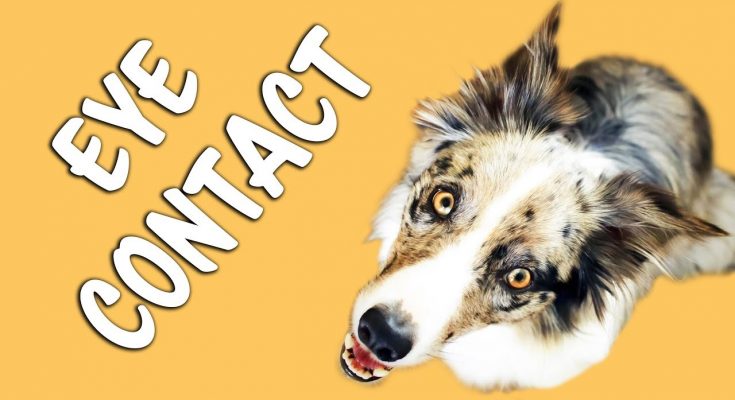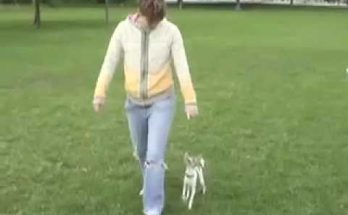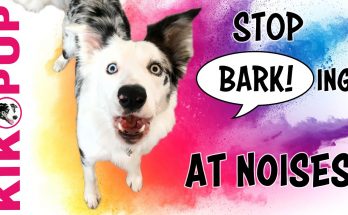This tutorial goes over the fastest and easiest method to teach your dog to offer attention and eye contact. This method is great for training any dog, be it a new puppy, rescue dog or an older dog who has not yet learned a cue to look at you. The benefits of training attention on handler are endless. When you train eye contact without using any forms of intimidation it can build your relationship and trust between you and your dog. Its also a great way to interrupt undesirable behavior in the future. Check out this video on how to interrupt behavior using an attention noise- https://www.youtube.com/watch?v=TBvPaqMZyo8
Thanks for watching! Please give a thumbs up, comment and subscribe! It means a lot to me 🙂
Check out my dogs’ daily antics on INSTAGRAM: https://www.instagram.com/kikopup/
FOLLOW ON FACEBOOK: https://www.instagram.com/kikopup/
CHECK OUT MY WEBSITE FOR FREE TRAINING ARTICLES, VIDEOS AND PRODUCTS: https://dogmantics.com/
The online store where you can find Professional Dog Training memberships, Self-study courses and video on demand for purchase: https://dogmantics.com/shop/
If you would like to support my work to create more educational videos like this one on how to train dogs without the use of physical or psychological intimidation, consider clicking the join button and becoming a member of channel Kikopup! It's kind of like the youtube version of patreon with perks. 🙂 Click this link here if a join button does not show up on your device such as a phone: https://www.youtube.com/user/kikopup/join
Happy Training!
– Emily Larlham (AKA Kikopup)





Don’t forget to show your love and give a THUMBS UP if you think the video deserves it 🙂 We appreciate it greatly as it helps the video to reach more people and their dogs.
Magically, this is the exact behaviour I was trying to learn to teach my dog today and then your video popped up in my feed. Thanks for the info.
Awesome! Good luck! 🙂
My partner & I just love your vids. I am a psychologist, a people trainer, and I still pick up great tips from you. You ALWAYS get a thumbs up from us. 🙂 And a fresh piece of baked chicken.
Hehe! Thanks! I’ll take a piece of dark chocolate.
After training Buddy, my wife and I had a child. We laughed when we caught ourselves using this same type of training with our daughter! – couldn’t help it, this training lends itself to all species.
I love how she fed Tug right after blowing in his face. It’s the same way I say sorry to me dog after doing something I know they don’t like.
🙂 thanks I probably shouldnt have shown what it looks like.. .haha. But I worked so hard on teaching him to not snap when someone blows in his face! 🙂
Thanks for this excellent brush up. Attention is everything.
Nice video! Learn something new everytime I watch you 🙂 what I miss in this video is a goal og this exercise. How much to raise criteria? What should I demand from my dog?
Great questions 🙂 Email me at dogmanticsstore@gmail.com and remind me of your question. But very basically- When you train eye contact without using any forms of intimidation it can build your relationship and trust between you and your dog. Its also a great way to interrupt undesirable behavior in the future. Check out this video on how to interrupt behavior using an attention noise- https://www.youtube.com/watch?v=TBvPaqMZyo8 For raising criteria, and what you should demand from your dog- the answer is “it depends”. A very very simplistic method is if the dog gets a behavior right 3 times and seems extremely confident, raise criteria a little, then go back on the next trial to the old criteria. Then depending on how hard the task is (if it involves a lot of physical effort) flip flop between difficult and easy. So with the eye contact if your dog is great at 5 seconds, you could do 5 seconds 1 second 3 seconds 8 seconds 3 seconds. Basically you are reinforcing on an average of 5 seconds and trying to increase the average. When your dog struggles 3 times in a row… that’s when I suggest to definitely lower criteria. But it depends a dog could get something wrong 1 time and I myself might go back and make things easier but 3 times is a definite the dog has no clue the training plan needs to be modified.
Teaching eye contact, as entry to clicker training, teaches the dog the parameters of clicker training. I aimed at 30 seconds (too long to be useful). Buddy went on walks off-leash, as he got ten times the exercise. I discovered he would “check-in” with me about every 8 seconds. Though it didn’t look it, our walks were very intimate.
Lovely advice as always. I recommend your channel to all dog owners I come across if they need help with training. Especially if they are getting a puppy.
Thanks!
Thank you SO much!!! I’ve been trying to teach this but Max hasn’t gotten it! He thinks he’s gotta look at the TREAT.
Good luck! 🙂 It’s ok if he looks at the treat in your hand when you are luring a behavior like a sit or a down. 🙂 So you can still use the behavior of him looking at the treat in your hand for that.
I have a service dog and have found that a lot of people in public will make an unwanted kiss noise at my dog as I pass. I have trained her to ignore such noises. I would choose a different noise than kissy if your dog has a low attention span and you want their attention in places especially like public. I mark my dogs eye contact as she offers it so it will be encouraged all throughout the day. I love your videos! They keep me heading in the right direction. 🙂
Good point. Here in san diego, no one has ever made a kissy noise at my dogs. But they have made squealing or “Awww!” noises, whistling and most annoying telling their kids to bark at my dogs. So I actually did work on people barking as a distraction because it used to scare my youngest dog. Yes, don’t choose a kissy noise if the place where you live people are trying to distract your dog with the noise (unless you have a shy dog that you want to learn to like strangers, because in that case its great if the strangers are making a noise that the dog likes)
This month’s Channel Kikopup MEMBERS ONLY post is up in the community section! It is a video on Raising Criteria in training sessions. If you are a member you can find the post here when you are logged in: https://www.youtube.com/user/kikopup/community
If you are not a supporting member of Channel Kikopup, there is a JOIN button you can press that’s next to the Subscribe button on my channel and under each of my videos. Or you can click this link to become a member to help fund channel Kikopup and access the monthly MEMBERS ONLY protected content. https://www.youtube.com/user/kikopup/join
Here is a video that gives you more information about the membership to Channel Kikopup: https://www.youtube.com/watch?v=k-VnSoP0o9Q&t=1s
In one of your older videos you had mentioned using that kissing sound to distract them from something instead of “no” or “ah ah” and this reminded me of a few questions I had about that. How does that not reinforce unwanted behavior when they get a treat every time they do it? Also why would you want to train them to give eye contact with a kiss sound when saying “eyes” or “attention” has the added benefit of them learning to respond to your voice specifically?
Well in a real life scenario, where the dog is doing something you dont like, you wouldn’t give them a treat, you can redirect them to a more appropriate behavior. The main way that behaviors change, is by reinforcing the behaviors you do want your dog to do. I like to teach a noise that always sounds the same, because clients tend to put their emotion into their dogs cues. When they are annoyed at their dog and interrupt them from something, they usually have an intimidating tone of voice without being conscious of it. They can never put intimidation into a kissy noise. Also people who tend to repeat their cues or dogs name- “fluffy! fluffy! fluffy! FLUFFY!!!!!!!!” usually when making a kissy noise, if it doesnt work the first two times, the person then realizes it doesnt work… instead of aimlessly repeating it.
Very helpful. Just started working on this the last few days with our ten week old pup.
Hello!
I love your videos! ❤ I just wish I came across then earlier when I first got my rescue 8 months ago. QUESTION She’s just over a year old now and whenever I make the kissy sound, her eyes shift to me for a split second then back to my hand (loves food) so I moved the food and clicker to behind my back so she has nowhere to look but me. Her head stays in place but her eyes shift to look away at anything. I click when she looks at me (really hard to catch) but she always looks away before I can feed the treat even with the sigh, I find I have to sigh multiple times to turn her head/ look back at me. I can’t get her to look at me for longer than a second, her eyes are always shifting even if her head won’t move..
But other times around the house when I don’t ask for her attention she will stare me down and make eye contact (usually when she needs something – walk, food, petting, go to her kennel, cuddles) how do I fix this?
Sidenote – do you have an appropriate mailing address where I can ask questions? I have no trainer and my rescue is pretty hard to work with 😭
I suggest that you proof the attention. I dont have a public video on it, but basically you hold the treats and constantly move them around in your hand, mark the moment your dog looks back at you and then extend the time your dog looks.
@Dog Training by Kikopup
Omg I can’t believe you replied! thank you so much oh my gosh 😊❤😭
This is great. I like the calming aspect of this too. Saw some nice eye blinking, chance in ear position. Now need to build duration. A work in progress.
Your videos are the best! My dog and I have learned a lot in 2 years. Thank you! For this simple eye contact game, is it best to have them in a down stay and you bring the treat to them while they hold the down stay? Thanks again.
Me: I’ll never be able to teach my dog to look at me she just keeps looking at the treats.
Als me after watching this 3 minute video an practicing for 5 minutes: yes we did it!
I absolutely love your videos. They are fast and concise making them so easy for me to watch and learn from. In preparation for pup coming in the summer I know I can set aside time to watch this playlist several times, and I will definitely be re-visiting all of these videos throughout training. Thank you for putting in the effort to make these wonderful videos.
I’m sure Emily is a great dog trainer. But most of her videos seem to be perfectly behaved dogs being fed treats. I’d like to see one of her with my (sometimes) obnoxious 10-week old Boston Terrier.
Just found your channel and I love your videos! I’ve been struggling with my 5 month old whippet so I hope your techniques help. Thank you.
In terms of the smoothness of the cooperation, the most important thing is good contact between the dog and the handler: it is the basis of all training.
There is a lot of talk about contact, but it is not only the dog looking at its handler. That’s why I wouldn’t use the often used term “eye contact”. Contact includes mutual trust and a desire to work together. It is more mental than physical. The demands are not only on the dog but also on the person: if you expect the dog to focus on you, you must also focus on your dog.
It is of the utmost importance to strengthen the dog’s voluntary contact throughout the initial training. If you entice the dog to make contact, it will not be there in the future, unless you entice the dog to do so. That wouldn’t be very useful. Otherwise, from the point of view of further training, it is extremely convenient if the dog offers contact itself. This is used when the dog is taught to tolerate disturbances and to pass people or other dogs.